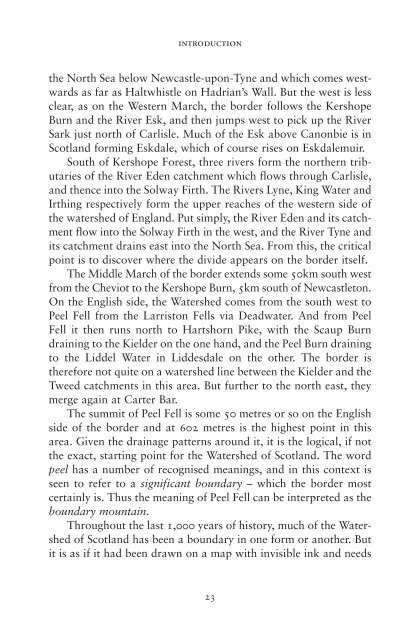Ribbon of Wilderness by Peter Wright sampler
If you’ve bagged the Munros, done the Caledonian Challenge and walked the West Highland Way, this is your next conquest. The Watershed of Scotland is a line that separates east from west; that divides those river basin areas which drain towards the North Sea from those which flow west into the Atlantic Ocean on the other. It’s a line that meanders from Peel Fell on the English border all the way to the top at Duncansby Head, near John O’ Groats – over 745 miles, through almost every kind of terrain. The Watershed follows the high ground, and offers wide vistas down major river valleys, towards towns and communities, into the heartlands of Scotland. Walk the Watershed in eight weeks Tackle short sections over a weekend 7 route maps Over 30 colour photographs Ribbon of Wildness provides a vivid introduction to this geographic and landscape feature, which has hitherto been largely unknown. The rock, bog, forest, moor and mountain are all testament to the Watershed’s richly varied natural state. The evolving kaleidoscope of changing vistas, wide panoramas, ever-present wildlife, and the vagaries of the weather, are delightfully described on this great journey of discovery.
If you’ve bagged the Munros, done the Caledonian Challenge and walked the West Highland Way, this is your next conquest.
The Watershed of Scotland is a line that separates east from west; that divides those river basin areas which drain towards the North Sea from those which flow west into the Atlantic Ocean on the other. It’s a line that meanders from Peel Fell on the English border all the way to the top at Duncansby Head, near John O’ Groats – over 745 miles, through almost every kind of terrain. The Watershed follows the high ground, and offers wide vistas down major river valleys, towards towns and communities, into the heartlands of Scotland.
Walk the Watershed in eight weeks
Tackle short sections over a weekend
7 route maps
Over 30 colour photographs
Ribbon of Wildness provides a vivid introduction to this geographic and landscape feature, which has hitherto been largely unknown. The rock, bog, forest, moor and mountain are all testament to the Watershed’s richly varied natural state. The evolving kaleidoscope of changing vistas, wide panoramas, ever-present wildlife, and the vagaries of the weather, are delightfully described on this great journey of discovery.
Create successful ePaper yourself
Turn your PDF publications into a flip-book with our unique Google optimized e-Paper software.
<strong>Ribbon</strong>s <strong>of</strong> Wildness_2016_Layout 1 24/05/2016 19:26 Page 23<br />
introduction<br />
the North Sea below Newcastle-upon-Tyne and which comes west -<br />
wards as far as Haltwhistle on Hadrian’s Wall. But the west is less<br />
clear, as on the Western March, the border follows the Kershope<br />
Burn and the River Esk, and then jumps west to pick up the River<br />
Sark just north <strong>of</strong> Carlisle. Much <strong>of</strong> the Esk above Canonbie is in<br />
Scotland forming Eskdale, which <strong>of</strong> course rises on Eskdalemuir.<br />
South <strong>of</strong> Kershope Forest, three rivers form the northern trib -<br />
utaries <strong>of</strong> the River Eden catchment which flows through Carlisle,<br />
and thence into the Solway Firth. The Rivers Lyne, King Water and<br />
Irthing respectively form the upper reaches <strong>of</strong> the western side <strong>of</strong><br />
the watershed <strong>of</strong> England. Put simply, the River Eden and its catch -<br />
ment flow into the Solway Firth in the west, and the River Tyne and<br />
its catchment drains east into the North Sea. From this, the critical<br />
point is to discover where the divide appears on the border itself.<br />
The Middle March <strong>of</strong> the border extends some 50km south west<br />
from the Cheviot to the Kershope Burn, 5km south <strong>of</strong> Newcastleton.<br />
On the English side, the Watershed comes from the south west to<br />
Peel Fell from the Larriston Fells via Deadwater. And from Peel<br />
Fell it then runs north to Hartshorn Pike, with the Scaup Burn<br />
draining to the Kielder on the one hand, and the Peel Burn draining<br />
to the Liddel Water in Liddesdale on the other. The border is<br />
therefore not quite on a watershed line between the Kielder and the<br />
Tweed catchments in this area. But further to the north east, they<br />
merge again at Carter Bar.<br />
The summit <strong>of</strong> Peel Fell is some 50 metres or so on the English<br />
side <strong>of</strong> the border and at 602 metres is the highest point in this<br />
area. Given the drainage patterns around it, it is the logical, if not<br />
the exact, starting point for the Watershed <strong>of</strong> Scotland. The word<br />
peel has a number <strong>of</strong> recognised meanings, and in this context is<br />
seen to refer to a significant boundary – which the border most<br />
certainly is. Thus the meaning <strong>of</strong> Peel Fell can be interpreted as the<br />
boundary mountain.<br />
Throughout the last 1,000 years <strong>of</strong> history, much <strong>of</strong> the Water -<br />
shed <strong>of</strong> Scotland has been a boundary in one form or another. But<br />
it is as if it had been drawn on a map with invisible ink and needs<br />
23


















